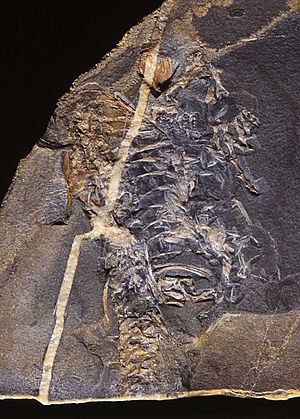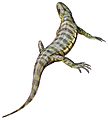Casineria facts for kids
Quick facts for kids CasineriaTemporal range: Middle Mississippian
|
|
|---|---|
 |
|
| Casineria kiddi from the Lower Carboniferous of Scotland | |
| Scientific classification | |
| Kingdom: | |
| Phylum: | |
| Subphylum: | |
| Class: |
Amniota (uncertain)
|
| Order: |
(uncertain)
|
| Genus: |
Casineria
|
| Binomial name | |
| Casineria kiddi |
|
Casineria was a tiny, four-legged creature that lived about 340 million years ago. This was during a time period called the Mississippian period. It was very small, only about 15 centimeters (6 inches) long. That's about the size of a pencil!
This ancient animal lived in a fairly dry area that is now Scotland. Scientists believe Casineria was one of the very first true amniotes. Amniotes are animals that lay eggs with a special membrane. This membrane helps the embryo develop on land, without needing water.
Casineria had a mix of features. Some were like early amphibians, which are more primitive. Others were more advanced, like later amniotes. This mix of traits makes it a very important fossil for understanding how animals evolved.
Sadly, the only fossil found is missing parts of its skull and lower body. This makes it a bit tricky for scientists to study it completely. Casineria ate insects. It was also special because it had five fingers with claws on each hand. These are the earliest known claws found on a land animal!
Its name, Casineria, comes from a Latin version of Cheese Bay. This is the place near Edinburgh, Scotland, where its fossil was discovered.
Discovering Casineria
In 1992, an amateur fossil hunter made an exciting discovery. They found the remains of this small, four-legged animal on the shore of Cheese Bay in Scotland. The fossil then went to the National Museum of Scotland in Edinburgh.
For five years, the fossil waited while researchers worked on other projects. Then, in 1997, scientists began carefully removing the stone around the fossil. This work helped them see more of the creature.
The discovery showed that Casineria likely lived in a much drier place than scientists first thought. These important findings were first shared with the world in 1999.
How Casineria Relates to Other Animals
Casineria has features that connect it to early tetrapods. Tetrapods are animals with four limbs, like amphibians, reptiles, birds, and mammals. Casineria was slender and had light leg bones. Its toes ended in claws.
These claws helped the animal grip the ground. This suggests that Casineria mostly lived on land. These traits show it was closely related to the first amniotes.
Because of its advanced features, Casineria might have been one of the very first true amniotes. These were animals that laid eggs on land, before the big split between Synapsids (which led to mammals) and Sauropsids (which led to reptiles and birds).
Casineria helps us understand that amniotes appeared much earlier than scientists previously believed. Casineria and its relatives were possibly the first vertebrates to live and reproduce entirely on land.
Images for kids


